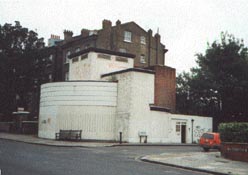
Belsize Park, Northern Entrance
Deep level shelters.
Eight shelters were built, all beneath existing underground stations
and seven on the Northern Line.
Each consisted of two parallel tunnels 1200 feet long and divided
into two floors. Four of the shelters, Belsize Bark, Camden Town, Clapham
North and Clapham South were fitted with bunks for 8000 people and used
as public air-raid shelters.
The other four (Goodge Street, Chancery Lane, Stockwell and Clapham
Common), were retained for government use. Chancery Lane and Clapham Common
provided emergency citadels during the V1 and V2 rocket attacks. Stockwell
housed American troops and Goodge Street, linked by Lamson pneumatic tubes
became a subterranean D-Day communication centre for General Eisenhower,
the Allied Supreme Commander.
Today the shelters still exist. Chancery Lane is part of the "Kingsway"
(Hardened Telephone Exchange). The remaining seven are all on the Northern
Line and are identifiable on the surface by their distinctive blockhouse
type entrances. Five, Belsize Park, Camden Town, Goodge Street, Stockwell
and Clapham South are used by a firm called Security Archives for storing
commercial data; Clapham Common is let to Britannia Data Management. Clapham
North is vacant. The leases for the shelters contains a clause which allows
the government to reoccupy them should the need ever arise, which we hope
it does not. (1)
In 1948 the Deep Tunnel at Clapham South provided temporary accommodation for 236 Jamaican immigrants that sailed to Britain on "The Windrush". Brixton was the nearest Labour Exchange so many settled nearby. (2)
"July, when the government opened 8 purpose-built deep shelters. Four on the north bank of the Thames at:
BELSIZE PARKEach 100ft underground and contained 8000 bunks, canteen and hospital facilities. Those lucky enough to get tickets felt like the aristocrats of the shelter world." (9)
CAMDEN TOWN
GOODGE STREET
CHANCERY LANE
and four on the south,
STOCKWELL
CLAPHAM NORTH
CLAPHAM COMMON
CLAPHAM SOUTH
"Post-war Chancery Lane was taken over by the Post Office and annexed to the Kingsway underground exchange. Camden Town was used as a set for a "Doctor Who" TV series and later in 1976 leased, together with Belsize Park, to Security Archives Limited." (8)
Mentioned as in use as a hostel in "Windrush" by Phillips and Phillips,Harper & Collins 1998.

"Post-war Goodge Street was turned into a processing centre for British troops passing through London until a fire in 1956. Later offered to the British Library for book storage but they turned it down." (3)
"......linked to CWR by Lamson Pneumatic tubes." (4)
"Part of Goodge Street was adapted in 1942 to serve as Eisenhower's HQ. The rest was used as a military transit camp until May 1956 when it was badly damaged by fire. It was re-equipped as a camp but fell into disrepair and was offered for sale in 1974 [this must be the date of my newsclip]. I toured it with a BBC-TV-team...."(5)
"The most famous is the one deep below Goodge Street underground station. On one of the platforms at one end is an obscure notice which warns of a deep shaft. This complex was used as a transit camp by troops on their way to Suez in 1956." (The Guardian N&Q April 23 1997)
Southern entrance, Shaft No. 6, (13) Bedford Road. Used as carpark for station staff. unused.
Peter Wright parked radio transparent RAFTER van in the forecourt
of Clapham Common air-raid shelter.
"Took power from the shelter and rigged up an aerial. Waited for
GRUFF signals. Air-raid shelter was south side of common.....drove around
trying to locate the receiver.....only to discover that it... must have
been right on top of us, listening within yards of the air-raid shelter.....behind
a high brick wall at the back of us was a large waste-land car park" (6)
Mentioned as in use as a hostel in "Windrush" by Phillips and Phillips, Harper & Collins 1998.